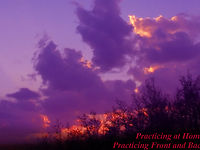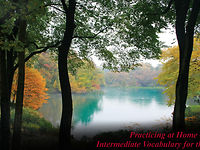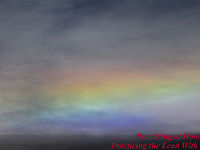Beramal di Rumah - Intermediate Vocabulary for the Follower
Followers sometimes say that, if the leader is any good, all they have to do is follow. But that's not completely right. The follower's job is also to learn the techniques for doing the movements well. And it would help if followers understood that the leader's job is to learn the techniques, learn the steps and pay attention to navigation.
The reason for the list of what the leaders have to pay attention to is to make the point that it's not true that the leaders have to do all the work. The follower's part in the dance is at least as big and active as the leader's part. It's just different. While it's "only technique", that's a big thing.
Practicing at home is partly about learning small techniques and then building upon them. Sort of like this:
"Begin by standing on a comfortable surface, where you have plenty of room at each side.
With a 5-lb potato bag in each hand, extend your arms straight out from your sides and hold them there as long as you can.
Try to reach a full minute, and then relax.
Each day you'll find that you can hold this position for just a bit longer.
After a couple of weeks, move up to 10-lb potato bags.
Then try 50-lb potato bags and then, eventually, try to get to where you can lift a 100-lb potato bag in each hand and hold your arms straight for more than a full minute. (David is at this level).
After you feel confident at that level, put a potato in each bag."
- Nama artis:
- Orchesta El Arranque
- Tajuk Album:
- Tango
- Laman Web Artis:
- http://www.orquestaelarranque.com.ar/
(condensed from their website): Started in 1996 with young musicians, Orchesta el Arranque has performed in 250 cities internationally.
- 00:05
- So, there are some exercises that followers can do,
at home all by themselves, as well... - 00:09
- ..in order to make the techniques for the intemediate steps
flow better when they're dancing. - 00:15
- So, for the gancho, again, there are two different
movements that you need to make... - 00:20
- ...and I've got this perfect tango dolly
to show you how to do that. - 00:25
- So, you do both, the open out movement...
- 00:28
- ..and the beginning of the gancho movement...
- 00:31
- ..and it's valuable to just practice that.
- 00:34
- So, there's the isolation in the leg...
- 00:39
- ...which we taught.
- 00:41
- D: But then there's also this, rotation in the hips.
N: And he's going to be opening. - 00:45
- And it's that co-ordination that would make
a lot of sense to practice together. - 00:51
- And just keep doing that until it's comfortable.
- 00:56
- So, and then, with the molinette,
so everybody theoretically... - 01:01
- ...has this nifty light, or you have a pole,
or you have a broom, something. - 01:05
- Take a string, and put it around the pole
or the broom or the light or whatever you have... - 01:11
- ..and then just do a molinette, so you stay
at the same distance all the way around. - 01:17
- If the light breaks, then you know
you went the wrong distance. - 01:20
- N: Actually, if it falls over, you know, too.
D: Right, if it falls... - 01:24
- As you get better, you can use more expensive lights.
- 01:26
- David. And then, despite the way this looks...
- 01:30
- ..this is really a wall or a door or, even better,
let it be the edge of a door. - 01:36
- And, for the drag, what we want you
to be able to do... - 01:39
- ..is pivot all the way around it and stay facing it.
- 01:42
- So, just on the edge of any door, do that.
- 01:44
- And you can do it to either side.
- 01:45
- So, for example, if you're facing your partner...
- 01:48
- ..you would then pivot a lot and go past.
- 01:52
- Keeping your energy and your face,
towards the partner. - 01:56
- Do it the other side.
- 01:57
- So you're facing your partner,
you pivot a whole ton... - 02:00
- ..and then you go past.
- 02:02
- And then your partner's right here,
so you're still facing them. - 02:05
- So, there are just things that you can practice,
that hopefully will make it lot easier... - 02:10
- ..and more beautiful when you come to do some of these
intermediate steps with a partner in a dance.




